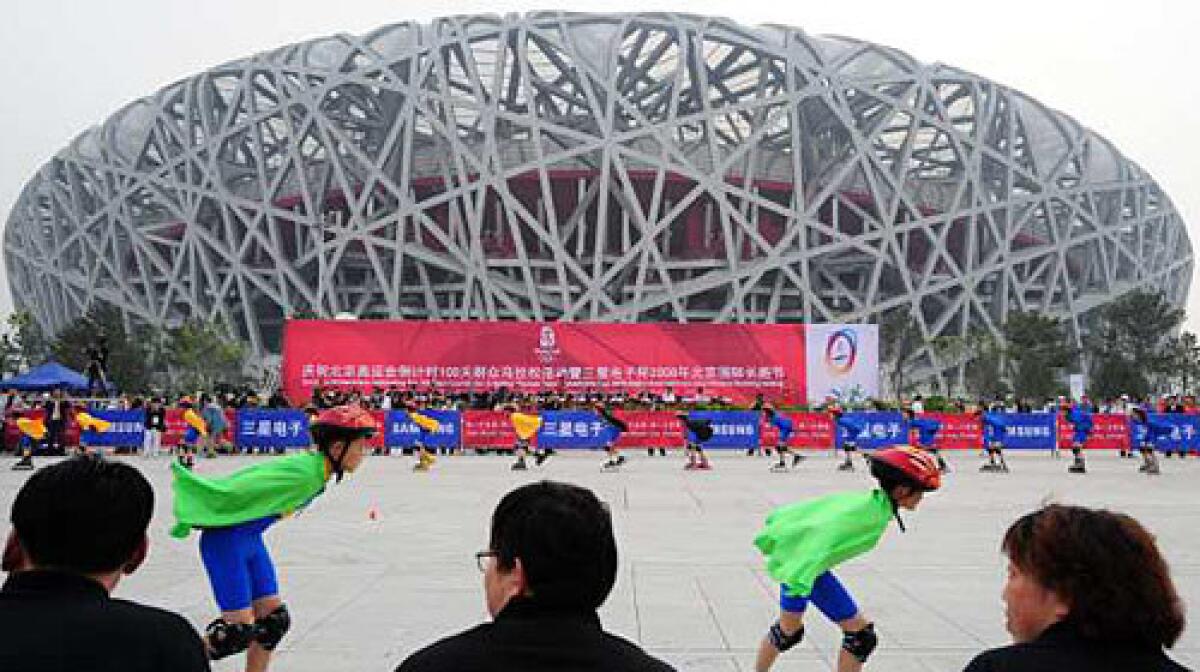Beijing is close to ready for Olympics amid lingering crisis

- Share via
BEIJING -- With 100 days to go, Beijing is bustling to complete a host of projects even as it juggles a global public relations crisis over the Tibet issue, the torch relay and limits on media access.
In marked contrast to Athens 100 days out, few at home or abroad have any doubt that China will have its stadiums finished, its doorknobs polished and its fireworks primed well in advance of the opening ceremony Aug. 8 at 8:08 p.m. China’s top-down system excels at mobilizing its energetic population behind national campaigns, and the Games are enormously popular among its 1.2 billion citizens.
“I think we’ll be quite ready and I’m very excited,” said Wang Jun, 36, a travel agent in Beijing. “We are hugely proud of our country. Foreigners will no doubt come away with a good impression.”
If spending is any measure, they should. At $2 billion, these will be the most expensive Games in history, not counting the estimated $38 billion spent on airports, highways, subway lines, office towers, parks, sewer systems and related infrastructure tied to the event.
The showcase 91,000-seat National Stadium -- which held its first test event this month, a race-walking competition -- will be the venue for the opening and closing ceremonies and various track and field events.
As the building has taken shape -- it is nicknamed the “Bird’s Nest” for the twisted metal forms adorning its exterior -- a pedestrian walkway straddling the nearby 4th Ring Road has become a hugely popular spot for tourists to gawk and snap pictures. The stadium will enjoy a full test run in late May during a three-day athletics event.
The Olympic village housing the 17,600 athletes and coaches and 7,000 media will open July 27, complete with a newly created forested area twice the size of Central Park as part of its commitment to stage a “green Olympics.”
The nearby blue-colored National Aquatics Center, nicknamed the “Water Cube,” opened in January and has been battle-tested in competition.
The $100-million to $200-million building -- actual spending has not been disclosed -- is covered in a special blue membrane that allows more heat and light in than traditional glass. It was originally supposed to have the world’s largest television set to display the competition within, before cost-cutting reined in that ambition.
The torch relay wrapped up its international run Tuesday in Vietnam. China wanted to mount the longest relay in the history of the Games, having dubbed it “a journey of harmony.” Instead it has been dogged by controversy and protests after riots broke out in mid-March in Tibet, leading to a crackdown.
The next three months will see the torch wend its way past millions of enthusiastic Chinese fans in Hong Kong, Macao and China’s 31 provinces and major cities, including jaunts through Tibet and to the top of Mt. Everest, all of which should be relatively free of controversy.
But various overseas media, civic, Darfur and pro-Tibet groups are expected to continue trying to pressure the Chinese government in the coming months.
“With just over 100 days to go to the Games, a key moment for the Olympic movement, we are campaigning to obtain the release of prisoners of conscience and free access to Tibet for the press,” said Robert Ménard, secretary general of Reporters Without Borders, a media-rights group, this week in one of several campaigns by groups around the world.
“Some amount of trouble is inevitable,” said Li Wei, 40, a security guard in Beijing.
“A few foreigners may have ulterior motives and want to hold China back, but I think most just don’t understand China.”
More to Read
Sign up for The Wild
We’ll help you find the best places to hike, bike and run, as well as the perfect silent spots for meditation and yoga.
You may occasionally receive promotional content from the Los Angeles Times.






